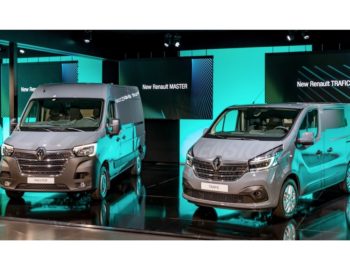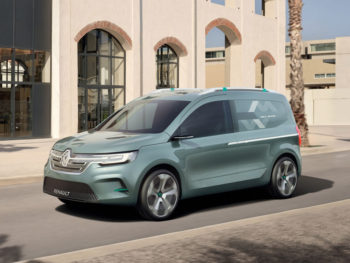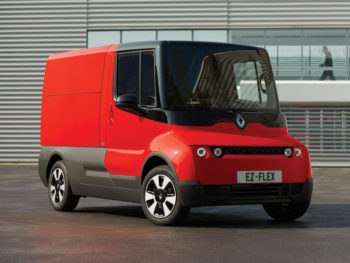Renault looks to maintain LCV leadership with updates and an electric vision, says Dan Gilkes.

Renault has updated its Trafic and Master vans, shown a concept version of the next-generation Kangoo and launched a two-year trial of the electric, connected EZ-FLEX urban delivery vehicle.
As part of the redesign, Trafic gets full LED headlights, standard on all but the most basic trim levels, offering a 34% improvement in visibility on dipped beam. Renault has installed a new 2.0-litre Euro 6d Temp diesel engine, delivering 120hp, 145hp and a range-topping 170hp. The 170hp engine delivers a 25hp boost over the previous generation, with a 40Nm uplift, to 380Nm, though Renault claims that the single variable turbo engine will offer up to a 10% fuel saving over the previous model.
Renault will also offer an automated gearbox option in Trafic, with the availability of a six-speed EDC (Efficient Dual Clutch) gearbox on both the 145hp and 170hp engines. The van also benefits from an improved overall specification, with front and rear parking sensors and a rear parking camera on the options list, along with Trailer Swing Assist.
The updated Master comes with a more upright grille and bumper, a higher bonnet line and LED headlights with the C-shaped daytime running light signiature that will be carried across all models. Inside, there’s a new dashboard design, with a 5” digital screen, revised steering wheel and improved seat fabrics. In-cab stowage has increased to 105 litres, with the availability of a smartphone charging pad and a choice of multimedia solutions, including Renault’s R-Link Evolution with media, nav plus Android and Apple connectivity.
Master keeps the 2.3-litre diesel engine, updated to Euro 6d Temp/Euro IV, depending on version. Power has been boosted, to a maximum 180hp, with up to 400Nm of torque. Lower ratings include 165hp, 145hp and 130hp.

There are updates to safety and driver assistance options, with Lane Departure Warning, Rear View Assist and Side Wind Assist on offer, while Autonomous Emergency Braking remains an option. The internal and external changes are adopted by Master Z.E. which can now be had in six versions, with two heights and three lengths. There are also two platform cab options available for the electric model, for conversion to high-capacity bodies of up to 22m3.
We have to wait until next year for the new Kangoo, but the Kangoo Z.E. Concept previews much of the styling and appearance of the van. This includes the C-shaped lighting signature, more rounded shoulders and pronounced wheel arches, creating a tougher looking van than the current Kangoo.

Renault has also unveiled the EZ-FLex, a connected urban delivery vehicle that could be provided with a range of bodies. The company will be testing 10 of the vans with customers in Europe over the next two years. However, EX-FLEX will not stay the same throughout the two-year period, but will be constantly updated to meet changing customer needs as part of the development process.
Renault’s commercial vehicle division is hoping to build on global sales of 620,000 vehicles in 2018, its best year ever and more than 34% up on the year before. With a €10bn turnover in 2018, Renault took a 6% share of the global LCV market. Much of that growth has come from China, where the company sells vans through the Renault Brilliance Jinbai company.
Looking forwards, as with other manufacturers, Renault is looking at other services and transport solutions that can be sold alongside the actual van. This will be driven by its Pro+ dealer network, which will grow from 660 dealers today, to a global total of more than 800 outlets by 2020.
“We are not just selling a van, we are selling a full solution, finance, the vehicle and a range of services,” said Thierry Plantegenest, vice president of sales and marketing.

